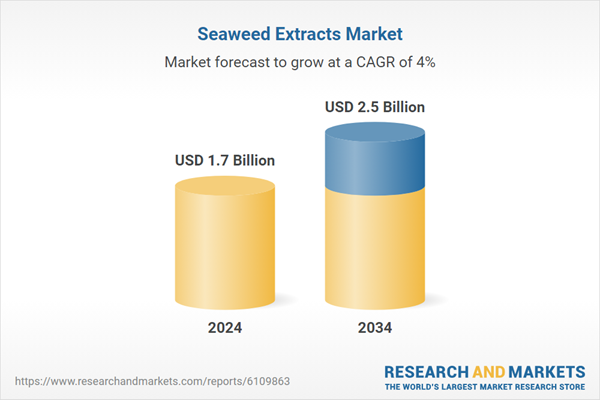Seaweed extracts serve as plant biostimulants and natural soil enhancers, improving nutrient uptake and soil aeration. Available in user-friendly forms such as soluble powders and flakes, seaweed extracts provide versatile organic solutions that integrate seamlessly with traditional and organic farming practices. These formats are easy to handle, store, and mix, making them ideal for large-scale agricultural use as well as smaller horticultural operations. In addition to acting as effective soil conditioners, they supply essential trace minerals like potassium, magnesium, and iron, which play a vital role in plant development and stress tolerance. Their natural chelating properties enhance the bioavailability of nutrients in the soil, improving uptake efficiency and overall plant health.
Liquid formulations segment in the seaweed extracts market generated USD 1.2 billion in 2024. Their ease of application and rapid absorption have made them a preferred option across a range of agricultural practices, particularly for foliar spraying and soil enhancement. Farmers favor these formulations due to their uniform consistency, reduced preparation time, and compatibility with standard irrigation systems. The effectiveness of liquid seaweed in improving crop resilience, nutrient uptake, and yield further drives its widespread use, especially in precision farming and organic cultivation methods.
The agriculture and horticulture segment accounted for a 33.1% share in 2024 and is projected to grow at a CAGR of 4.3% through 2034. As growers increasingly shift toward sustainable inputs, seaweed extracts have gained traction as natural biostimulants and soil conditioners. Meanwhile, in the food and beverage sector, seaweed-derived compounds such as carrageenan and agar are experiencing strong demand as clean-label alternatives to synthetic additives. Their ability to deliver texture, viscosity, and shelf-life improvements in sauces, dairy substitutes, and ready-to-eat products reinforces their critical role in reformulated and plant-based offerings.
United States Seaweed Extracts Market generated USD 456.1 million in 2024. Growth in the region is driven by demand across agriculture, food, cosmetics, and pharmaceuticals. Increasing awareness around organic farming and stress resilience in crops has fueled adoption in biostimulant markets. Meanwhile, the shift toward clean-label ingredients in food and the rise in natural cosmetics have boosted the use of seaweed-based thickeners, stabilizers, and skincare beneficials like antioxidants and anti-inflammatories.
Major players operating in the Seaweed Extracts Market include Algaia S.A., DuPont de Nemours, Inc., Roullier Group, Gelymar S.A., and Cargill, Inc. Leading firms are boosting their R&D investments to develop high-purity, standardized extracts tailored for specific end-markets. They’re forming partnerships with agricultural cooperatives, food manufacturers, and skincare brands to integrate seaweed extracts into new bio- and eco-based products. Companies are also enhancing traceability by implementing sustainable sourcing programs and obtaining certifications to meet clean-label and organic standards. In addition, expanding production capacity and establishing facilities near major seaweed farming regions ensures supply reliability and cost efficiency. Firms leverage strategic acquisitions and joint ventures to diversify product portfolios-combining algal biostimulants with complementary inputs.
Comprehensive Market Analysis and Forecast
- Industry trends, key growth drivers, challenges, future opportunities, and regulatory landscape
- Competitive landscape with Porter’s Five Forces and PESTEL analysis
- Market size, segmentation, and regional forecasts
- In-depth company profiles, business strategies, financial insights, and SWOT analysis
This product will be delivered within 2-4 business days.
Table of Contents
Companies Mentioned
- Acadian Seaplants Limited
- Algaia S.A.
- Cargill, Inc.
- CP Kelco (J.M. Huber Corporation)
- DuPont de Nemours, Inc.
- Gelymar S.A.
- Qingdao Gather Great Ocean Algae Industry Group
- Roullier Group
- Seasol International
Table Information
| Report Attribute | Details |
|---|---|
| No. of Pages | 263 |
| Published | June 2025 |
| Forecast Period | 2024 - 2034 |
| Estimated Market Value ( USD | $ 1.7 Billion |
| Forecasted Market Value ( USD | $ 2.5 Billion |
| Compound Annual Growth Rate | 4.0% |
| Regions Covered | Global |
| No. of Companies Mentioned | 9 |









